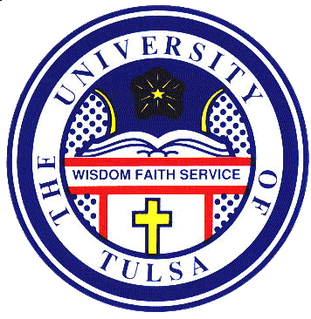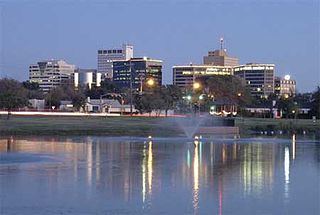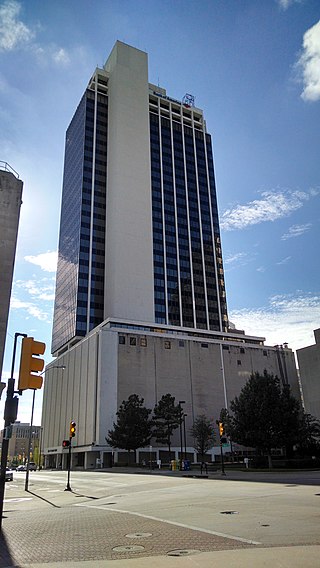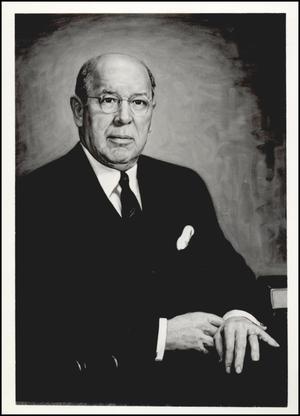Petroleum Building may refer to:
- Petroleum Building (Tulsa), a building in Tulsa, Oklahoma
- Petroleum Building (Midland), a building in Midland, Texas
Petroleum Building may refer to:

The University of Tulsa (TU) is a private research university in Tulsa, Oklahoma. It has a historic affiliation with the Presbyterian Church, although it is now nondenominational, and the campus architectural style is predominantly Collegiate Gothic. The school traces its origin to the Presbyterian School for Indian Girls, which was established in 1882 in Muskogee, Oklahoma, then a town in Indian Territory, and which evolved into an institution of higher education named Henry Kendall College by 1894. The college moved to Tulsa, another town in the Creek Nation in 1904, before the state of Oklahoma was created. In 1920, Kendall College was renamed the University of Tulsa.

Jenks is a city in Tulsa County, Oklahoma, United States, and a suburb of Tulsa, in the northeastern part of the state. It is situated between the Arkansas River and U.S. Route 75. Jenks is one of the fastest-growing cities in Oklahoma. The city's population was 16,924 in the 2010 census, but by 2020, this had grown to 25,949. The Census estimated Jenks' population as 27,553 in 2023.

Bartlesville is a city mostly in Washington County and Osage County, Oklahoma. The population was 37,290 at the 2020 census. Bartlesville is 47 miles (76 km) north of Tulsa and 18 miles (29 km) south of the Kansas border. It is the county seat of Washington County. The Caney River runs through Bartlesville.

Midland is a city in the U.S. state of Texas and the seat of Midland County with small portions extending into Martin County. The population was 132,524 as of the 2020 census. Located in the Permian Basin in West Texas, Midland is a major center for American oil and natural gas production.

The Permian Basin is a large sedimentary basin in the southwestern part of the United States. It is the highest producing oil field in the United States, producing an average of 4.2 million barrels of crude oil per day in 2019. This sedimentary basin is located in western Texas and southeastern New Mexico.

North Sea oil is a mixture of hydrocarbons, comprising liquid petroleum and natural gas, produced from petroleum reservoirs beneath the North Sea.

Waite Phillips was an American petroleum businessman who created a fully integrated operation that combined petroleum producing, refining and marketing. With headquarters in Tulsa, Oklahoma, he also developed several office complexes and engaged in banking and ranching. Phillips was a philanthropist for both local Tulsa institutions and national causes. In Tulsa he built a 72-room mansion for his residence, which he later donated to the city; it became the Philbrook Museum of Art. He gave 127,000 acres (510 km2) of his favorite ranch in New Mexico to the Boy Scouts of America, together with an office building as part of its endowment. The ranch is now Philmont Scout Ranch, one of the largest youth camps in the world. Phillips also made a substantial bequest to the University of Southern California, which named a building after him.
The Midland Valley Railroad (MV) was a railroad company incorporated on June 4, 1903 for the purpose of building a line from Hope, Arkansas, through Muskogee and Tulsa, Oklahoma to Wichita, Kansas. It was backed by C. Jared Ingersoll, a Philadelphia industrialist who owned coal mining properties in Indian Territory. The railroad took its name from Midland, Arkansas, a coal mining town in western Arkansas, which was served by the railroad. The Midland Valley gained access to Fort Smith, Arkansas via trackage rights over the Frisco from Rock Island, Oklahoma.
The title of "Oil Capital of the World" is often used to refer to Tulsa, Oklahoma. Houston, Texas, the current center of the oil industry, more frequently uses the sobriquet “The Energy Capital of the World.”

ConsumerAffairs is an American customer review and consumer news platform that provides information for purchasing decisions around major life changes or milestones. The company's business-facing division provides SaaS that allows brands to manage and analyze review data to improve their products and customer service. ConsumerAffairs was founded in 1998 by Jim Hood. The company has been headquartered in Tulsa, Oklahoma since 2010 and also has offices in Austin, Texas, the Philippines, and Argentina.

SageNet Center, originally known as the Exposition Center from 1966 to 2007 and QuikTrip Center, until 2012, and River Spirit Expo from 2013 to 2021, is the center of the Tulsa State Fair and one of the largest clearspan buildings in the world. The Expo Center provides 354,000 square feet (32,900 m2) of column-free space under a cable-suspended roof. The building spans 448,400 total square feet on two levels, connected by side ramps and stairs, allowing for a variety of show floor plans.

The Bank of America Center is a commercial high-rise building in Tulsa, Oklahoma. The building rises 412 feet in downtown Tulsa. and contains 288,776 square feet (26,828.2 m2) of space. It has 32 floors, and was completed in 1967 as the Fourth National Bank of Tulsa. It is located on the corner of Sixth Street and Boulder Avenue, the site of the former Tulsa County court house. The Bank of America Center currently stands as the 5th-tallest building in the city, and the 9th-tallest building in the state of Oklahoma. The architectural firm who designed the building was Kelley & Marshall of Tulsa. The Bank of America Center contains offices of the Charlotte-based Bank of America Corporation. It currently stands as the 2nd-tallest international style skyscraper in the city, behind the BOK Tower. It also houses the offices of several petroleum companies and the Oklahoma State Attorney General's office.

The 110 West 7th Building is a commercial high-rise building in Tulsa, Oklahoma. The building rises 388 feet (118 m), making it the 7th-tallest building in the city, and the 14th-tallest building in the U.S. state of Oklahoma. It currently stands as the 3rd-tallest International Style skyscraper in the city, behind the BOK Tower and the Bank of America Center. The building, with its black and white grid exterior floodlighted at night, is a Tulsa landmark.

The Petroleum Building is a 50-meter/10-floor building at 420 South Boulder in Tulsa, Oklahoma. It was built in 1921, and is a steel and reinforced concrete structure faced with buff brick. The name was given because most of the early tenants were associated with the petroleum industry. Later, it housed the Mayo Brothers Furniture Company. It was identified as one of the supporting structures during the creation of the Oil Capital Historic District.

William Grove Skelly was an entrepreneur who made a fortune in the oil business. Born in Erie, Pennsylvania, he moved to Kansas in 1916, then to Tulsa, Oklahoma, in 1919, where he founded Skelly Oil Company. By 1923, his company was one of the strongest independent producers of oil and gasoline in the United States. He helped organize the first International Petroleum Exposition in Tulsa in 1923 and became president of that organization, a position he held for the rest of his life. He was a founder of the Kansas-Oklahoma branch of the United States Oil and Gas Association, then known as Mid-Continent Oil and Gas Association.

The Mayo Building at the northwest corner of West Fifth Street and South Main St. in Tulsa, Oklahoma was built in 1910. It had five stories. It was expanded by a duplicate building to the north in 1914, and further expanded by addition of 5 more stories in 1917. It was listed on the National Register of Historic Places (NRHP) in 2008.
Vital Energy, Inc. is an American company engaged in hydrocarbon exploration incorporated in Delaware with its principal operational headquarters located in Tulsa, Oklahoma.
The International Petroleum Exposition (IPE) was a specialized trade fair held in Tulsa, Oklahoma, at varying intervals from 1923 to 1979. Its main purposes were to display the latest oil industry technology, sell equipment and services, and to educate industry workers and the general public about the production of oil.

The Oil Capital Historic District (OCHD) is an area in downtown Tulsa, Oklahoma that commemorates the success of the oil business in Tulsa during the early 20th century. During this period, Tulsa was widely known as "The Oil Capital of the World." The area is bounded by 3rd Street on the north and 7th Street on the south, Cincinnati Avenue on the east and Cheyenne Avenue on the west.